List five subjective data history questions for the abdomen
What is appetitive, dysphagia, food intolerance, abdominal pain, nausea/vomiting, bowel habits, past abdominal history, medications and nutritional assessment?
Name two possible differential diagnosis when pt c/o dysphagia and/or difficult swallowing solid foods
What is esophageal stricture, webbing or narrowing (Schantzki ring) and neoplasm?
Name four things you inspect of the abdomen
What is
• Contour of abdomen
• Round, flat, protuberant,
scaphoid
• Scars and/or striae
• Engorged veins
• Visible peristalsis
• Visible pulsation
• Hair Distribution
• Evidence of hernia
Four assessment signs of inflammation
What is swelling, warmth, redness, and pain or tenderness?
These four common risk factors increase a patient's likelihood of developing cardiovascular disease and should be assessed during every cardiac evaluation.
What is
Hypertension
Hypercholesterolemia
Diabetes
Obesity
Smoking
Sedentary life style
List two subjective follow up questions for a patient regarding their appetite
What is recent weight loss, an increase or decrease, and eating the same amount?
Name two possible differential diagnosis for a pt c/o abd pain located suprapubic
What is Bladder infection, Constipation, Bladder cancer and Prostatitis?
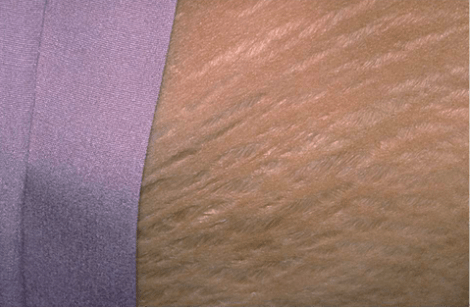
What is striae?
Name three causes of decreased ROM
What is arthritis, joints with effusion, joints with
tissue inflammation or surrounding fibrosis, or bony fixation (ankylosis)?
This systolic murmur is best heard at the right upper sternal border and radiates to the carotids; it often indicates narrowing of this valve.
What is aortic stenosis?
List three subjective follow up questions for a patient complaining of dysphagia
What is
How long has this been occurring?
Does this occur with a certain type of food?
Have you had this in the past?
If you had in the past, did anything help it?
How does it feel?
Name two specific types of hernias
What is ventral hernias (defects in abdominal wall), prior surgery (incisional), and spontaneously (epigastric, umbilical, femoral and inguinal)
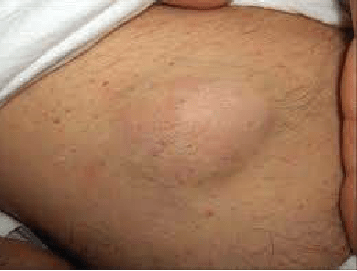
What is a lipoma (subcutaneous tumors/benign fatty tumors)?
Description of the Apley Test and possible diagnosis if patient has difficulty performing
What is ask patient to touch the opposite scapula using behind neck and under arm (see photos!) and rotator cuff disorder or adhesive capsulitis?
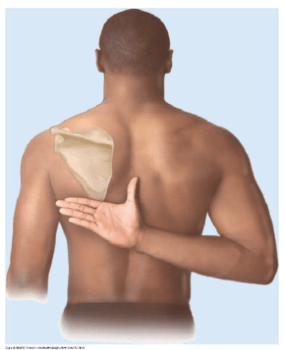
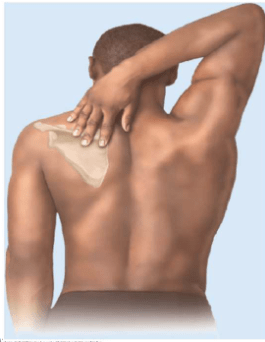
This diastolic murmur is best heard at the apex with the patient in the left lateral decubitus position and is often described as a low-pitched "rumble" associated with this valvular disorder.
What is mitral stenosis?
List three subjective follow up questions for a patient complaining of abdominal pain
What is where does it hurt, how long, describe the pain(burning, stabbing, cramping), does it keep you awake or awaken you from sleep, severity?
Pt presents with jaundice, name 1 extraheptic and 1 intraheptic possible differential diagnosis
What is
Extrahepatic
• Biliary obstruction
Intrahepatic
• Viral hepatitis
• Alcoholic hepatitis
• Drugs
• Sepsis
• Malignancy
• Sickle Cell
Exam performed when pt presents with RUQ pain suspicious for acute cholecystitis but does not have any tenderness on palpation in the RUQ and describe how to perform
What is Murphy sign and hook your fingers of your right hand under the costal margin, ask patient to take a deep breath and tenderness with a sudden stop in inspiratory effort is a positive sign?
Name this and possible cause
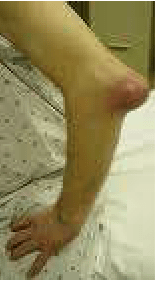
What is olecranon bursitis and trauma or rheumatoid or gouty arthritis?
This extra heart sound, often heard in early diastole with the bell of the stethoscope at the apex, is associated with increased ventricular filling pressure and may indicate heart failure.
What is an S3 gallop?
List one subjective follow up questions for a patient for food intolerance and possible diagnosis
What is does this worsen with certain foods, after eating dairy running to bathroom (lactose intolerant), RUQ pain after fried foods (gallstones), and regurgitation with spicy foods (acid reflux/GERD)?
Possible diagnosis for pt presents with severe peri umbilical pain migrating to RLQ and one exam you would perform
What is acute appendicitis and testing for McBurney's Point, psoas, obturator, rovsing?
Name the exam being performed and if enlarged cause of enlargement
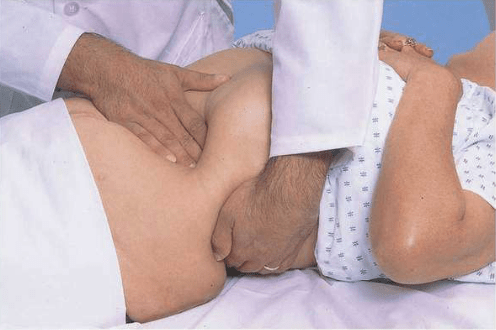
What is palpating spleen and portal hypertension, hematologic malignancies, HIV infection, infiltrative diseases like amyloidosis, and splenic infarct or hematoma ?
Describe how to perform the Varus test and possible diagnosis if positive
What is place one hand against the medial
surface of the knee and the other
around the lateral ankle then push laterally against the knee and pull medially at the ankle to open the knee joint on the lateral side (varus
stress) and Pain or a gap in the lateral joint line
points to ligamentous laxity and a
partial tear of the lateral collateral
ligament.
During cardiac auscultation, this maneuver can help distinguish hypertrophic cardiomyopathy from other murmurs by increasing the intensity of the murmur when performed.
What is the Valsalva maneuver?